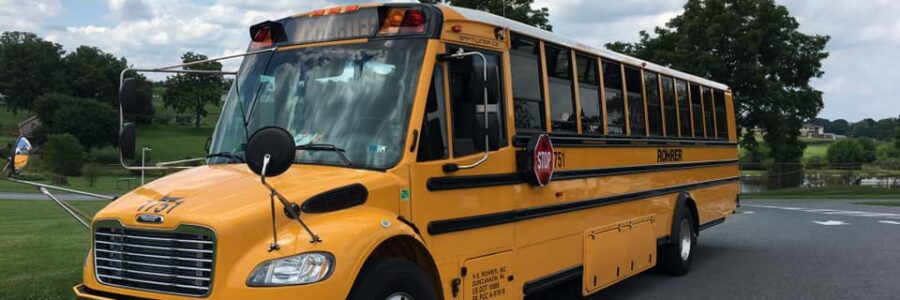
School buses ensure the safe transportation of millions of students to and from school every day. They are an integral part of our education system and understanding the frequently asked questions related to these vehicles can help you ensure efficient operations and inclusivity for all students.
School buses have various safety features, including:
Drivers also undergo specialized training that ensures safe bus operation and student well-being.
The National Highway Traffic Safety Administration (NHTSA) recommends that all passengers on a school bus must be seated while the vehicle is in motion — standees and aisle seating are prohibited. This rule keeps students safe while the bus is in motion, preventing injuries in case of accidents or sudden stops. These vehicles have specific seating configurations that accommodate the maximum number of passengers while maintaining essential safety standards.
In 1938, a snowstorm in Sandy, Utah, drastically reduced visibility for a school bus driver when the vehicle came to a stop at a railroad crossing. The driver wrongly assumed the railroad was clear to cross but was quickly hit by a freight train mid-cross. The law does not require school bus drivers to open their doors at railroads in all states, but they must come to a complete stop at least 15 feet away from the railroad to confirm safety.
Bus drivers who choose to open their doors at railroad crossings get a clear view, allowing them to listen for approaching trains. This gives students a chance to evacuate quickly and efficiently in an emergency.
A school bus’s Gross Vehicle Weight Rating (GVWR) varies depending on several factors, like intended capacity and other operational requirements.
School buses range in size from 9,900 to 36,000 pounds GVWR with the limiting factor being the type of chassis, engine, and seating capacity. There are four types of school bus classifications:
There are some significant upfront costs that come with the purchase of a school bus, which can be offset by its longevity and efficiency over several years of service.
The average new 72 passenger school bus costs between $130,000 and $160,000. Buses that cater to students with disabilities may come at a higher cost due to accessibility features, such as wheelchair lifts and wheelchair securement devices. Before buying a school bus, factor in the operating costs to ensure it aligns with your organization’s budget. These overheads include:
A school bus’s life span varies depending on environmental conditions, maintenance and usage. A well-maintained vehicle with a clean-diesel engine can last over 15 years unless there are regulatory requirements or safety considerations that call for a particular bus’s early retirement.
As the electric school bus market grows, more districts will have electric buses in their fleets. Various federal, local, and state programs offer funding, grants, or incentives for buying energy-efficient, environmentally friendly school buses. These programs promote cleaner air through emission reduction, which also improves transportation efficiency.
Electric buses are fuel efficient, and with fewer moving parts, they can decrease maintenance costs. Investing in these energy-efficient vehicles offers several benefits, including compliance with environmental regulations, better air quality around communities and schools, and long-term cost savings thanks to lower operational and maintenance expenses. Communities benefit from less noise pollution and no tailpipe emissions. Students, especially those who have sensitivity to loud noises, benefit from the quieter ride.
School buses should be inclusive and accessible environments for students of varying abilities and needs. This inclusivity shows up in the design, driver training, and efforts to create a comfortable and safe transportation experience for all students. Accessibility features may include:
Vehicle size determines how many seats are on a school bus. Depending on the bus design, standard school buses can seat about 72 students if there are three passengers per bench seat. Some will have wheelchair accessibility and securement systems for passengers with disabilities. These buses can also feature inclusive seating that accommodates students with varying needs, including students with disabilities and specific seating preferences.
Maintenance and upkeep are two vital aspects that ensure vehicles are safe and reliable. Common maintenance challenges are:
School buses undergo regular maintenance that includes fluid checks, routine inspections, and filter replacements at predetermined intervals. These intervals are usually every six months or 15,000 miles, depending on which qualifying factor comes first. Conduct emergency preparedness tests like testing emergency exits, driver readiness, and students’ understanding of these procedures.
School buses are symbols of efficiency, safety, and inclusivity in our education system. Understanding the key aspects related to these vehicles helps to ensure secure, smooth transportation for students and communities.
For over 100 years, Rohrer Bus has supplied local businesses, government agencies and schools with transportation solutions. We proudly deliver efficient, safe transport through a range of solutions that include large group charters, special needs school bus rides, and more. Partner with your new bus transportation service provider today or purchase the vehicle your operations need by contacting Rohrer Bus!
We’re looking for dependable people to join us in Driving the Future Forward! Explore Open Positions